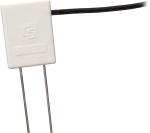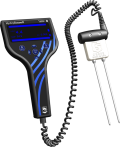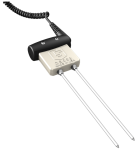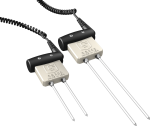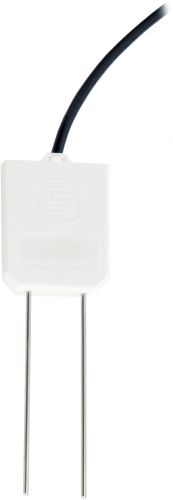
バルクECの高い土壌でより正確






利点と特徴
- サンプル量が多いため誤差が少ない
- 土質と電気伝導率の影響を補正した測定値
- 広範囲の鉱物性土壌の土壌含水量を推定
- 多項目センサ: 誘電率、バルク電気伝導率(EC)、土壌温度を測定
イメージ

詳細
仕様
| 測定項目 | 土壌電気伝導率 (EC)、比誘電率、体積水分含有量 (VWC)、土壌温度 |
| 必要なシステム | 測定システム |
| 土壌適合性 | 短いロッドは硬い土壌に簡単に設置できます。電気伝導率の高い土壌に適しています。 |
| ロッド | 交換不可 |
| センサ | 互換性なし |
| 感知範囲 | 3600 cm3 (各プローブ ロッドの周囲半径約 7.5 cm、ロッドの端から 4.5 cm) |
| 電磁 | CE準拠 (静電気放電およびサージに対する保護に関する EN61326 要件を満たしています。) |
| 動作温度範囲 | -50° ~ +70°C |
| センサ出力 | SDI-12; シリアル RS-232 |
| ウォームアップ時間 | 3 秒 |
| 測定時間 | 測定に 3 ミリ秒、SDI-12 コマンドの完了に 600 ミリ秒 |
| 電源要件 | 6 ~ 18 Vdc (12 Vdc で 45 mA を供給できる必要があります。) |
| 最大ケーブル長 | 610 m (2000 フィート) 同じデータロガーのCポートに接続された最大 25 個のセンサの合計長さ |
| ロッド間隔 | 32 mm (1.3 in.) |
| 侵入保護等級 | IP68 |
| ロッド直径 | 3.2 mm (0.13 in.) |
| ロッド長さ | 120 mm (4.7 in.) |
| プローブヘッド寸法 | 85 x 63 x 18 mm (3.3 x 2.5 x 0.7 in.) |
| ケーブル重量 | 35 g / メートル (0.38 oz / ft) |
| プローブ重量 | 240 g (8.5 oz) ケーブル除く |
消費電流 |
|
| アクティブ (3 ms) |
|
| 静止 | 135 µA (通常) (@ 12 Vdc) |
EC |
|
| 溶液 EC の範囲 | 0 ~ 8 dS/m |
| バルク EC の範囲 | 0 ~ 8 dS/m |
| 正確度 | ±(読み取り値の5% + 0.05 dS/m) |
| 精密度 | BECの0.5% |
比誘電率 |
|
| 範囲 | 1 ~ 81 |
| 正確度 |
|
| 精密度 | < 0.02 |
体積含水率 |
|
| 範囲 | 0~100% (M4 コマンド使用時) |
| 水分含有量の正確度 |
|
| 精密度 | < 0.05% |
地温 |
|
| 範囲 | -50° ~ +70°C |
| 分解能 | 0.001°C |
| 正確度 |
|
| 精密度 | ±0.02°C |
互換性
注意: 以下は代表的な互換性情報を示しています。互換性のある製品や互換性のない製品をすべて網羅したリストではありません。
Data Loggers
| 製品 | 互換性 | 注意 |
|---|---|---|
| CR1000 (リタイア) | ||
| CR1000X (リタイア) | ||
| CR300 (リタイア) | ||
| CR3000 (リタイア) | ||
| CR310 | ||
| CR350 | ||
| CR6 | ||
| CR800 (リタイア) | ||
| CR850 (リタイア) |
互換性に関する追加情報
RF(無線周波数)に関する考慮すべき事柄
外部RFソース
外部 RF ソースはプローブの動作に影響を与える可能性があります。したがって、プローブは、AC 電源ラインやモータなどの重要な RF ソースから離れた場所に設置する必要があります。
プローブ間の干渉
標準データロガー SDI-12 「M」 コマンドを使用する場合、複数の CS655 プローブを 4インチ以内に設置できます。SDI-12「M」コマンドでは、一度に有効にできるプローブは1つだけです。
オプションの取り付けツール
CS650G ロッド挿入ガイドツール
CS650Gを使用すると、密度が高い土壌や岩の多い土壌でも土壌水センサを簡単に挿入できます。このツールは、CS650Gを使用しなければセンサを損傷する可能性のある力で土壌に打ち込むことができます。センサのロッドを挿入するための下穴を開けることができます。
ドキュメント
ダウンロード
CS650 / CS655 Firmware v.2 (429 KB) 02-12-2015
Current CS650 and CS655 firmware.
Note: The Device Configuration Utility and A200 Sensor-to-PC Interface are required to upload the included firmware to the sensor.
よくある質問
CS655に関するよくある質問の数: 55
すべて展開すべて折りたたむ
-
バルク電気伝導率 (EC) 測定はセンサロッドに沿って行われ、ロッドが配置されている深さに関係なく、その距離にわたる EC の平均読み取り値となります。
-
いいえ。これらのセンサが機能する原理は、液体の水の誘電率が 80 近くあるのに対し、土壌の固体粒子の誘電率は約 3 ~ 6 であるということです。ガソリンやその他の炭化水素の誘電率は土壌粒子と同じ範囲にあるため、CS650 および CS655 では基本的に検出されません。
-
体積水分含有量の読み取り値は、センサのロッドの長さ全体にわたる平均水分含有量です。
-
報告される体積水分含有量の測定値はロッドの全長に沿った平均値であるため、センサは土壌に完全に挿入する必要があります。そうしないと、測定値は空気と土壌の両方の平均となり、水分含有量が過小評価されることになります。センサ ロッドが長すぎて土壌に完全に入らない場合は、ロッドが土壌に完全に覆われるまで斜めに挿入することを推奨しています。
-
室温での水の誘電率は 80 に近くなります。CS650 と CS655 の両方のファームウェアは、誘電率の測定値が 42 を超えると体積水分含有量を NAN または 9999999 に変更するようにプログラムされています。水中でテストする場合は、水分含有量の測定値ではなく誘電率の測定値を確認してください。機能性のテストを行う場合は、センサを水から半分ほど引き出して、誘電率と体積水分含有量の測定値の両方を確認します。
-
サーミスタは、ステンレス ロッドの 1 つに隣接するセンサのエポキシ ヘッドに収納されています。これにより、センサ ヘッドのその部分が土壌と接触する深さでの温度の正確なポイント測定が可能になります。このため、CS650 または CS655 の推奨方向は水平配置です。温度測定は、センサ ロッドの長さ全体で平均化されるわけではありません。
-
CS650 および CS655 センサは、SDI-12 コマンドを使用して一度に 1 つずつ読み取られます。したがって、これらのセンサは同時にアクティブになることはなく、電気的に干渉し合うこともありません。センサを近くに設置する場合、一般的なガイドラインとしては、センサ間の距離を少なくとも 10 cm 離してください。
-
Campbell Scientific では、センサ ケーブルの接合は推奨していません。センサはカスタム ケーブル長で注文できますが、Campbell Scientific では、アプリケーションに適した長さの購入を推奨しています。センサ ケーブルを長くする必要がある場合は、接合よりもジャンクション ボックス (可能な場合) の方が適しています。
注意: DIYによる延長はセンサの保証が無効になりますが、ジャンクション ボックスではセンサが変更されないため、保証は無効になりません。
-
はい。砂利の場合、設置時にセンサ ロッドを平行に保つのは特に困難ですが、可能です。砂利には大きな間隙があり、水はけが速いため、水分含有量の測定値は飽和状態と非常に乾燥した状態の間で急激な変化を示す可能性があります。乾燥端での水分含有量の小さな変化が重要な場合は、期間平均を体積水分含有量に直接変換するために、土壌固有の校正を実行する必要がある場合があります。
-
海水の電気伝導率 (EC) は約 48 dS/m です。CS655 は、EC が 0 ~ 8 dS/m の水の誘電率を測定できます。導電率が 8 dS/m を超えると、EC の測定値は非常に不安定になり、NAN または 9999999 として報告されます。EC は誘電率方程式の一部であるため、EC の測定値が NAN の場合、誘電率の測定値も NAN になります。したがって、CS655 は海水中で正確な測定値を提供できません。
海氷に関しては、海水が凍結すると電気伝導率が大幅に低下し、水が液体から固体に変化するため、誘電率が約 88 から約 4 に低下します。EC と誘電率の両方が CS655 の測定範囲内のレベルまで低下するため、センサは海氷中で有効な測定値を提供すると考えられます。センサは頑丈で、低温に耐えることができます。しかし、氷が溶けるにつれて、電気伝導率が高くなりすぎて、誘電率または電気伝導率の有効な読み取り値を取得できなくなるポイントが存在します。
ケーススタディ
ユタ州地質調査所は、ユタ州水利権局の支援を受けて、ユタ州全域に蒸発散量を測定するための渦相関観測所のネットワークを構築しました。これらの観測所は、陸地からの水の蒸発と植物による水の蒸散を合わせた量を測定します。消費的使用、つまり植物によって吸収され蒸散される水は、耕作地を含む植生地帯の蒸発散に大きく貢献します。 ユタ州の水管理者が農業活動によって節約または使用される水を正確に判断するには、同州における水使用の地上測定の改善が不可欠です。ユタ フラックス ネットワーク (UFN) の目的は 2 つあります。1 つは、渦共分散法を使用してフィールドでの蒸発散量を測定し、そのデータを衛星で収集した測定値と比較することです。この目的のため、UFN はこれまでに 4 つの渦共分散ステーションを設置しており、今後もさらに設置する予定です。 これらのステーションは、研究グレードの計測機器のコア セットから構築されています。各ステーションには次のものが含まれます。 データロガー(CR1000XまたはCR6) 統合型音波風速計付きガス分析装置 (IRGASON) 温度および相対湿度プローブ(EE181-L) 4ウェイネットラジオメーター(NR01-L) 土壌熱流計(HFP01-L) 土壌温度センサー(TCAV-L) 土壌水分センサー(CS655およびSoilVue™10) 機械式風速計と風向計 光合成有効放射線(PAR)センサー 太陽光発電システム 各観測所は、観測所の風上地域に出入りする水蒸気、CO2、エネルギーの動きを正確に測定します。純放射計と土壌センサーは、エネルギーバランスと土壌熱流束を研究するために使用されます。これらの機器はすべて非常に正確で、その多くは極めて高い速度で測定値を取得できます。 ユタ州サンファン郡の......続きを読む
持続可能なイノベーションのための国際パートナーシップ 農業における水利用の改善は、気候変動にうまく適応するために不可欠です。FarmImpact プロジェクトでは、ドイツと南アフリカのパートナーが技術的ソリューションと生態学的アプローチを組み合わせて、南アフリカの西ケープ州におけるワインや果物の栽培の微気候と生産性に対する防風垣の影響を調査します。 南アフリカは、今後数十年で気候変動とそれが農業、ブドウ栽培、果樹栽培に及ぼす悪影響に関して、より大きな課題に直面することになります。アグロフォレストリーシステムは、農業の気候変動への適応に貢献することができます。研究プロジェクト「南アフリカのアグロフォレストリー - 変動する気候下での革新的な土地利用システムの新しい道筋」(ASAP) は、気候変動の影響への適切な対応として、農業地帯に樹木を植えることを目指しています。このプロジェクトは、ドイツ、ナミビア、南アフリカの研究機関と大学間の共同研究プロジェクトを確立するための研究プログラム「SPACES II - 南アフリカの複雑な地球システムプロセスへの適応のための科学パートナーシップ」に貢献しています。このプログラムは、地球システム管理に関する科学的推奨事項の策定に貢献し、この地域の複数の生態系サービスの持続可能な利用を確保することを目的としています。SPACES II は、ドイツ教育研究省 (BMBF) の資金提供を受けています。 農業用水の利用の調査 水不足は、気候変動の影響、人間の脆弱性、生物多様性と生態系機能の喪失とともに、南アフリカにおける最大の課題の 1 つです。特に農業は、顕著な乾期と水不足によって脅かされています。小麦、ワイン、果物の栽培の中心地である西ケープ州は、国の食糧安全保障にとって非常に重要です。これに加えて、南アフリカは長年にわたり、ヨーロッパへの農林産物の主要輸出国となっています。 ドイツ、コットブスのブランデンブルクエネルギー技術センター(CEBra)のマイク・ヴェステ博士とドイツ、ミュンヘベルクのライプニッツ農業景観研究センター(ZALF)のロジャー・ファンク博士は、南アフリカのステレンボッシュ大学植物学・動物学部のケリー・アン・グレイとガイ・ミッドグレイと共同で、ステレンボッシュ地域の柑橘類の果樹園とブドウ園における樹木と作物の相互作用を調査しています。その目的は、発見された環境上の利点を利用して、農業景観に統合する必要がある革新的で多目的な土地利用管理方法としてのアグロフォレストリーシステムの利用を支援することです。したがって、典型的なアグロフォレストリーシステムを体系的に調査し、隣接する一年生作物と永年作物の放射と熱収支に対する樹木の影響を判断します。この文脈では、個々の樹木、防風林、または小規模の森林でさえも、周囲の地表温度に好ましい影響を及ぼし、それが隣接する作物の熱とエネルギーのバランスに特に良い影響を与えます。この目的のために、Apogee Instruments......続きを読む
このケーススタディでは、中国科学院清遠森林 CERN 研究所の不均一な地形におけるCO 2 /H 2O微量ガスフラックスを測定する理論と技術を探すためにCPEC310およびAP200システムを統合する方法について説明します。 CPEC310 (閉路渦相関システム) と AP200 (大気プロファイル システム) は、微気象センサー、硝酸塩関連の微量ガス分析装置、土壌表面 CO 2フラックス システムとともに、中国科学院清遠森林 CERN フィールド研究所における森林生態学と管理に関する研究を促進する 3 つの高さ......続きを読む
Privacy Policy Update
We've updated our privacy policy. 詳細はこちら
Cookie Consent
Update your cookie preferences. クッキーの設定を更新する

